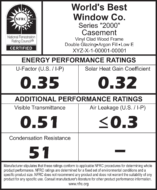Are you doing a windows project?
Modernize can pair you with three to four pros in your area, so you can compare options and save time and money.
When it comes time for a window replacement, there’s a lot to think about and a lot of decisions to be made as far as materials go — but it doesn’t have to be difficult.
Window ratings — the colorful numbers, letters and insignias often placed in corners of the glass — serve as identifiers to help both homeowners and contractors identify a window’s make, model, materials and efficiency. Different ratings can make for drastically different window performance since the grades help indicate how a window will perform in different types of climates and extreme weather.
For that reason, understanding how window ratings work can be a great advantage when it comes to setting your home up for success. Modernize is here with a guide to help you know what to look for when it comes to window ratings.

NFRC Label
The NFRC label, which stands for the National Fenestration Ratings Council, notes how a window’s performance does when measured by the organization’s performance standards.
Found in the upper right corner of windows, the NFRC label will help identify a window’s make, model, style and the materials used to create it.
To meet certification standards, the NFRC tests windows by looking at factors including heat transfer, sun-blocking, air leakage, condensation resistance, and more. The NFRC label doesn’t necessarily mark a good or bad window. Instead, it displays the test results for five testing categories.
Here’s a breakdown of what the NFRC label grades for. We will get into expanded descriptions of each of the terms later on:
| Factor | What does it mean? | Range listed | What is a good score? |
|---|---|---|---|
| U-Factor | It measures how well a product insulates a home, preventing heat from escaping | .2-1.20 | The lower the grade, the better the product is at keeping heat inside |
| Visible Transmittance | It measures the amount of light passing through a window and into a home | 0-1 | The higher the number, the more natural light will come into your home |
| Condensation Resistance | It measures to what extent a window will resist forming condensation on the inside | 1-100 | The higher the number, the more resistance the window has |
| Solar Heat Gain Coefficient (SHGC) | It measures how well a product resists undesired solar gain | 0-1 | The lower the grade, the less undesired heat gain in a house |
| Air Leakage | It measures how much air from outside will leak into a room | ≤ 0.3 | The lower the number, the less drafty |
Energy Star
ENERGY STAR ratings on windows are helpful for homeowners because they verify that the windows use 20–30% less energy than their counterparts. This, in turn, leads to significant long-term savings on windows.
There are three factors that determine whether a window can be an Energy Star Window:
- U-factor — indicates how easily heat flows through a window. The lower the U-factor, the more insulative the window will be.
- SHGC (solar heat gain coefficient) — estimates the amount of heat-causing light that can travel into a home through the window. Lower numbers here signify that less solar heat is allowed in.
- Air leakage rating (AL) — gauges the amount of air allowed through the frame and joints, per square foot of window space. Windows with a lower AL rating allow less air to flow through.
The type of windows you will need depends largely on what climate you live in, which is why the ENERGY STAR rating for windows varies by region:
- In northern climates, a low U-factor and higher SGHC are necessary to receive an ENERGY STAR certificate. This allows your home to be properly insulated and take advantage of passive solar heat from the windows.
- In southern climates, the minimum U-factor rating for ENERGY STAR certification is slightly higher, but the SGHC is lower. This reduces the amount of excess solar heat in the home. That is why it is so important to buy the right ENERGY STAR windows for your location.
Condensation Resistance Rating
The condensation resistance rating measures to what extent a window can resist forming condensation within the inside surface.
Condensation forms on surfaces where the temperature is cooler than the air’s dew point. That’s why homeowners see water droplets and ice on their windows, especially in areas with more humidity.
Find the Right Contractor for Your Windows Project
Whether you’re ready to begin your project now or need some expert advice, our network of contractors are here to help. With a few simple questions, we’ll find the best local professionals for you
While ratings don’t predict if condensation will form or not, the rating can help homeowners understand how a window’s condensation buildup will compare against another. The higher the rating’s number, which is measured on a scale from 1 to 100, the more resistant it is.
R-Value
A window’s R-Value measures the amount of heat the glass on a window retains. The R-Value is considered the counterpart to the U-Factor, which measures how much outdoor heat the glass can keep out.
R-Values are measured on a scale from R-3.57 to R-8 for windows and different ranges for other materials that are measured for insulation capabilities, like doors. Good R-Values for windows are considered anything higher than an R-5.
The R-Values can help a homeowner or contractor understand a window glass’ energy efficiency and insulation abilities. Factors that can impact the rating include the number of panes on a window’s glass, the type of frame it is going into and its size.
Visible Light Transmittance
Visible light transmittance measures the amount of natural light that will enter your home through a window’s glass. The scale, which slides between 0 to 1, illustrates how much light isn’t filtered through. The larger the number, the more light will come through. For example, a .5 rating would mean that 50% of the light is getting through while .95 means that 95% is coming through. Energy-efficient windows will score between .5 and .7, which allows a good amount of natural light without overly heating your home or sun-bleaching fabric inside. Treatments like glazing can impact a window’s visible light transmittance score. It’s important to discuss your home priorities with a licensed contractor to find the right balance.
AAMA, WDMA, DP and more
There are a lot of groups, ratings and scores to consider when it comes to a window replacement. Some are based on region.
Highly regarded groups, like the American Architectural Manufacturers Association (AAMA) and the Window and Door Manufacturers Association (WDMA) will sometimes work in tandem to publish studies on the efficacy of window and door materials.
Both groups will issue grades and ratings on materials. The AAMA’s rating is used in regions for replacement windows while the WDMA’s certification signifies code compliance and encourages manufacturers and suppliers to produce high-quality products.
A DP or design pressure rating is a numerical grade given to building materials — including windows and doors — based on their ability to withstand weight, water, and air infiltration. The higher the rating, the better the window can withstand the elements.
What this means for homeowners
If this feels like a lot of information to retain, don’t fret.
Windows — and other home improvement materials — all come with ways to grade and compare products to one another. But it doesn’t mean you need to become a walking encyclopedia of window rankings.
Window ratings can be a great tool to easily compare different materials to one-another when selecting replacements for your home. An effective window rating can tell a homeowner or contractor how energy efficient a window’s glass will be and if it will keep air-conditioning in while keeping outdoor heat and cold weather out.
The main window ratings to consider fall into ENERGY STAR’s measurement system: the U-Factor, solar heat gain coefficient and the air leakage rating are worth being mindful of because of the impact efficient windows can have on your home’s overall efficiency. Still, there are some things best left to the professionals.
Modernize recommends discussing your top priorities regarding your home and upcoming window project with a licensed contractor. They will be able to tell you not only what various window ratings mean, but how they can apply to your home’s specific needs. The right decision will not only help keep your home comfortable for years to come, but can help bring down utility bills and increase your home’s value.
Find the Right Contractor for Your Windows Project
Whether you’re ready to begin your project now or need some expert advice, our network of contractors are here to help. With a few simple questions, we’ll find the best local professionals for you
Reviews from Real Homeowners
Welcome to Homeowner Resources! We are the Modernize blog. Modernize pairs more than 3 million homeowners a year with pre-vetted contractors in their area. This blog started because we believe homeowners should know everything about their homes, from how their HVAC works to which front door colors they might love. On Homeowner Resources, you can find information on every part of your home, right down to how you can negotiate with contractors to get the best price. Here's more about the blog.
Need a contractor? Learn more about how Modernize finds the right pro for you.





